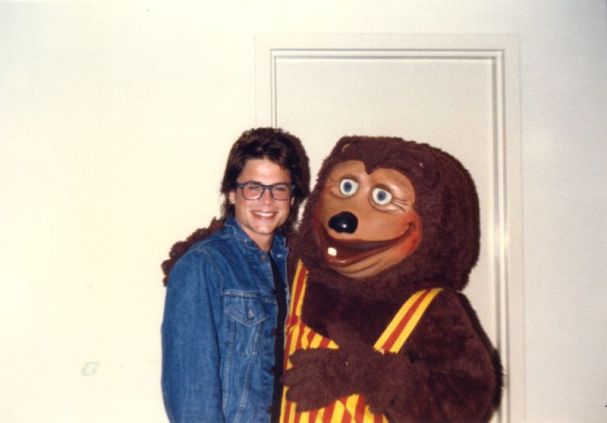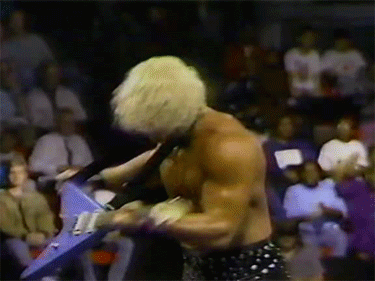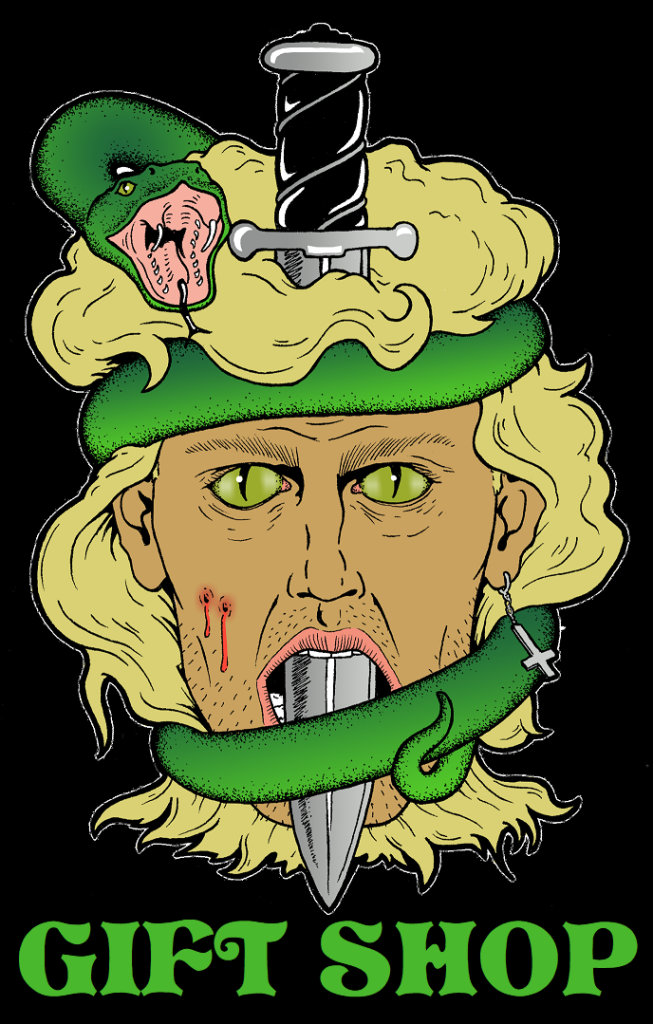MAY’S LOCAL HOT SPOT OF THE MONTH: CHUCK E. CHEESE’S.

If your idea of a night on the town in 1992 was…
#1 Stuffing your face with pizza & cake
#2 Running around like a mental patient
#3 Barfing in the corner
It probably means you’ve experienced a night at Chuck E. Cheese’s!

It’s fascinating to think that one of the most popular birthday party hot spots of our childhood was a place that smelled like a bodacious blend of sweat and pizza grease. The arcade (originally titled “The Fantasy Forest”) was a chaotic free-for-all, fun and slightly dangerous at the same time. Once your cake-high started to burn off from playing 79 games of skeeball and drowning in the ball pit, it was time for the weirdest part of the night: the giant robot critter band coming to life! (We’ll discuss that a little later).
Like it or loathe it, Chuck E. Cheese’s is without a doubt a revolutionary establishment. While others have tried to capitalize on the family entertainment/restaurant franchise throughout the years (remember DZ: Discovery Zone?), the only one still standing and showing no signs of going anywhere is the house with the mouse.
But did you know that dream almost died in 1984 when Chuck E. Cheese’s filed for Chapter 11 bankruptcy? Did you know the company was created by the co-founder and head of ATARI? Did you also know the place was originally going to be named “Rick Rat’s Pizza”? How about in Australia when they had to name the restaurant “Charlie Cheese’s Pizza” because the most common word for vomit in the land down under is “Chuck”!
The Pizza. The Games. The Cake. The Barf. Strap yourselves in and get ready for May’s Local-Hot-Spot-Of-The-Month:
CHUCK E. CHEESE’S

CHAPTER 1: THE RAT-THEMED PIZZA PALACE IS BORN.
It all started with the founder of Atari, Mr. Nolan Bushnell. After creating Pong and watching Atari explode, Bushnell was looking to expand his horizons beyond the video game industry and he realized he wouldn’t be able to remain competitive in the the market. His original concept for Chuck E. Cheese’s was for a family atmosphere where kids could discover video games. The only current public places at that time featuring arcade games were bars and pool halls.
During the initial planning stages for Chuck E., the idea and design came from a generic mascot-character costume that Bushnell obtained from a trade show. Everyone figured it was a coyote, which lead to the original working title of the restaurant being “Coyote Pizza”. Bushnell shipped the costume back to Atari and once they noticed a large pink tail indicating it was actually a rat, they kept it and went with a rat theme.
 Nolan Bushnell and “Rick Rat”, on his way to becoming Chuck E.
Nolan Bushnell and “Rick Rat”, on his way to becoming Chuck E.
Bushnell had already been calling his newly acquired rat costume Rick Rat, so the company decided on “Rick Rat’s Pizza” for the restaurant’s name. Bushnell was so confident in his concept that he felt one day it would compete with big leagues like Disney (they had Mickey Mouse, he had Ricky Rat). Once Atari’s PR people found out about Rick Rat, they were appalled that a dirty rat would be used as a restaurant mascot. However, the agency said it would be acceptable if they focused less on the rat theme and also give him a different name.
Eventually Atari’s people agreed on “Chuck E. Cheese” (the E stands for Entertainment), the name being alliterative of Mickey Mouse.

CHAPTER 2: BLAST OFF.
The debut of Chuck E. Cheese’s Pizza Time Theater came in 1977 at their San Jose, CA location. It was the first of it’s kind, a unique establishment offering pizza, animated entertainment and an indoor arcade. The most innovative aspect of the Pizza Time Theater was the animatronic show, which entertained guests as they were waiting for food or taking a break from pumping money into the token machine. The show featured a group of life-sized crusty animals performing as a band with Chuck E. Cheese as their frontman.
The genius behind using animatronics again came from Bushnell. He realized pizza and entertainment worked after seeing a restaurant called Pizza and Pipes draw in large crowds to watch an organ be played while they ate. Not wanting to pay a performer but seeing the value of a “show” aspect, Bushnell knew animatronics were the answer.
The Pizza Time Theater was an instant success and the company immediately began to franchise. Bushnell inked a deal for financial support with Bob Brock, chairman of a massive hotel corporation. They agreed to open 16 Chuck E. Cheese locations.

CHAPTER 3: STIFF COMPETITION.
In the midst of Chuck E Cheese’s gaining momentum and rising in popularity, Bushnell’s new partner Brock had been talking off the radar with an up and coming inventor named Aaron Fletcher.
Fletcher created animatronics far more advanced than Bushnell’s robots who were charming but awkwardly stiff in physical nature. His creatures were smoother in movement, their facial expressions changed and the drumsticks actually hit the drums. Fletcher and Bushnell had actually crossed paths before when Bushnell attempted to buy Fletcher’s creations just a couple years prior, but the deal fell through. Now Brock and Fletcher decided to start their own competing restaurant called ShowBiz Pizza. The animatronic-dancing animal pizza rival was conceptually identical to Chuck E Cheese’s, except that ShowBiz was aimed at more of a teenage crowd. During its early years customers reported that the restaurant was more dimly-lit than Chuck E Cheese’s and offered a more pizza parlor-ish vibe.
Their band called Rock-Afire Explosion was headed by Billy Bob, a bad ass hillbilly bear in overalls. The other anthropomorphized animal characters in the band included a grey wolf, a silverback gorilla, and other species. They performed medleys of classic rock, pop, and country music, as well as original compositions and comedic skits.
 ShowBiz superfan Rob Lowe hanging out with Billy Bob.
ShowBiz superfan Rob Lowe hanging out with Billy Bob.
Savage competition began between the two companies. With both restaurants operating simultaneously, sometimes even opening up locations in the same town, Chuck E. Cheese’s sued ShowBiz. They eventually settled out of court with ShowBiz agreeing to pay Chuck E. a portion of its profits over the next decade. Despite the win, Chuck E. Cheese filed for bankruptcy in 1984, and ShowBiz bought the franchise the following year. Instead of sending the friendly rat riding into the sunset, the two businesses carried on with Chuck and Billy Bob sometimes appearing together in advertisements.

Soon after the two companies merged and became just plain old Chuck E. Cheese’s Pizza. Sadly this began the slow death of ShowBiz’s Rock-Afire Explosion band. The show was sold to other restaurants and entertainment centers, such as Circus Pizza, Pistol Pete’s Pizza, and Billy Bob’s Wonderland.
These days a cult following of ShowBiz disciples roam the earth, including an extensive fansite and also one devotee who purchased the original Rock-afire Explosion band robots and costumes. Search out “The Rock-afire Explosion Documentary” to check that out.
CHAPTER 4: THE INFINITE.
While many people make disgusted facial gestures when the name Chuck E. Cheese’s gets brought up in conversation, Uncle T always hands it to the legendary pizza palace for standing the test of time all these years. The restaurant went through some changes throughout the 1990’s and 2000’s, but its core elements were never put to rest.
Other corporate restaurant chains from yesteryear can’t say the same. Take for instance Pizza Hut. Believe it or not, the ‘Hut was a fairly respected family-outing pizza restaurant at one time. Best part though? It still had ATMOSPHERE. Brick buildings, signature red-roofs, dimmed lighting, red vinyl booths, generic Italian decor, jukeboxes, soda inside those red semi-transparent cups, table top video games, movie promo items, etc. These days? The ‘Hut has been reduced to a fast-food joint that sits in the corner of ugly plazas. Why the huge decline? That’s an entirely other discussion to get into.

Maybe this post will inspire you to swing on over to your neighborhood Chuck E. Cheese’s for a few beers and maybe a drunken face-plant into the ball pit (and yes, Chuck’s serves beer and wine now). For a company that’s lasted over 30 years, it’s worth a shot.
Big thanks to the historians over at ShowBizPizza.com for the enlightening info on these two restaurant powerhouses.
[Local-Hot-Spot-Of-The-Month is a adrenaline-thrusting history lesson and celebration of signature hangout spots one might recognize from television, film or real life. Our objective is to not just rediscover and dissect these places, but more importantly create a feeling like you’re really there. Take your time with these entries. Hang out. Turn some music on.
To visit the rest of ’em, go here.]





